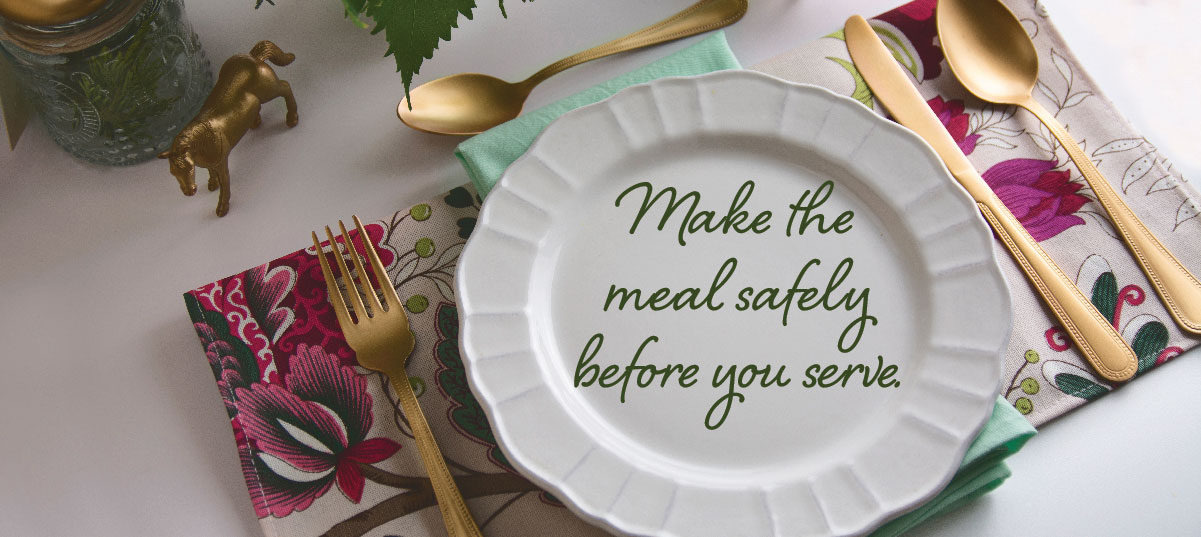It's a New Day in Public Health.
The Florida Department of Health works to protect, promote, and improve the health of all people in Florida through integrated state, county, and community efforts.
Holiday Cooking - Make the Meal Safely Before You Serve
December 12, 2019

It’s holiday cooking season and time to plan your meals. Whether you’re cooking plans include mastering family recipes or tackling new ones, the Florida Department of Health reminds you to keep your food safety skills sharp this season.
Most illnesses that erupt after eating are caused by bacteria, germs, that have found their way into a meal. According to the U.S. Food and Drug Administration (USDA), bacteria can double within 20 to 30 minutes—that means one bacteria turns into two, then two become four, leading eventually to millions of cells in a few hours. There are lot of opportunities for bacteria to grow and multiply in a kitchen that’s less than safe: unclean surfaces and hands, undercooked food and spoiled food are the big culprits.
It takes a little extra time to cook safely and it’s worth the effort. Foodborne illness, or food poisoning, causes nausea, vomiting, stomach cramps and diarrhea—symptoms can be mild or very serious. The Centers for Disease Control and Prevention estimates that 48 million people get sick every year from foodborne illness: on average, 128,000 are hospitalized and 3,000 die.
So keep your holidays merry and bright! The Department recommends the following to reduce your chances of foodborne illness.
Thawing should be part of your cooking plan. Thaw food in a refrigerator that’s set at 40 degrees or below—this is the safest way to thaw frozen food. A large frozen turkey needs at least 24 hours for every 5 pounds of weight to thaw safely. Even small amounts of frozen food like a pound of ground meat or boneless chicken breasts need 24 hours to thaw in the refrigerator. Learn more, visit the USDA’s “The Big Thaw” page.
Clean before and after cooking. Wash your hands, kitchen utensils and surfaces before and after preparing food—especially after working with meat, poultry, eggs or seafood. Hot soapy water is all you need to keep countertops and cooking areas clean.
While you’re preparing: separate–don’t cross contaminate. Keep raw meats, poultry, eggs and seafood, and their juices, away from other foods. A cutting board used for meats should not be used for other foods like vegetables, fruits, herbs and cheeses.
Cook to the right temperature. Many recipes call for specific internal cooking temperatures. It’s hard to judge temperature by look or touch. Using a reliable food thermometer will help make your kitchen a safety zone and it can improve your cooking. For pre-made foods, always follow label directions.
Watch the clock and refrigerate. Refrigerate or freeze within two hours all foods that can spoil quickly. Make sure your refrigerator is set at 40 degrees or below, and your freezer is set at 0 degrees.
Reheating leftovers. Sometimes the best meal is the one waiting for you in the fridge or freezer. Leftovers, including frozen leftovers that have been safely thawed, should be heated to 165 degrees. And don’t guess—use your handy food thermometer.
We all need reminders—especially during the holidays. Download our food safety sheet.
This FloridaHealth.gov feature story is provided by the Florida Department of Health’s Office of Communications. It can be reused without permission, but kindly list the Florida Department of Health as a source and include the month and year.



Connect with DOH